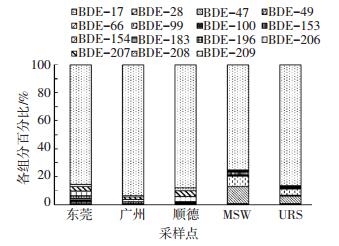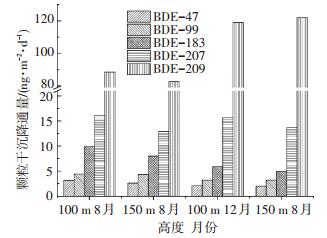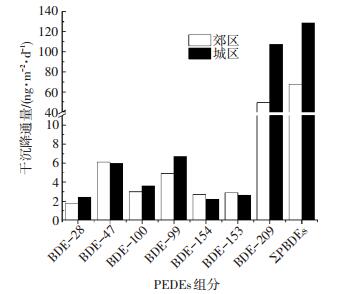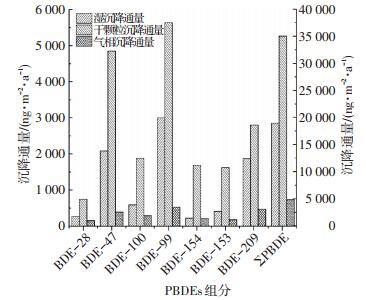2. 城市水资源与水环境国家重点实验室(哈尔滨工业大学), 哈尔滨 150090;
3. 国际持久性有毒物质联合研究中心, 哈尔滨150090
2. State Key Laboratory of Urban Water Resource and Environment(Harbin Institute of Technology), Harbin 150090, China;
3. International Joint Research Center for Persistent Toxic Substances, Harbin 150090, China
多溴联苯醚(polybrominated diphenyl ethers, PBDEs)的化学通式为C12H(0-9)Br(1-10)O,是含有溴原子的一种芳香族化合物,根据溴原子个数可以分为10个同系组,根据溴原子在苯环上的取代位置和取代数量不同,共分为209个组分[1].多溴联苯醚是溴系阻燃剂的一种,具有阻燃效率高、热稳定性好、添加量少、对材料性能影响小、价格便宜等优点[2],广泛应用于各种工业产品和日用产品中.工业多溴联苯醚主要分为五溴联苯醚(以四、五溴代联苯醚为主)、八溴联苯醚(以六、七、八溴代联苯醚为主)和十溴联苯醚3种,多溴联苯醚的3种工业产品在室温下呈浅黄色液体或者白色粉末状固体.作为工业产品,由于多溴联苯醚为添加型阻燃剂,在产品受热过程中很容易从产品中脱落,挥发到大气中,伴随着降水等气象因素进行迁移[3].
多溴联苯醚具有持久性有机污染物(persistent organic pollutants, POPs)的特性:生物积累性、环境持久性、生物毒性以及长距离迁移能力[4].2007年中国禁止生产五溴联苯醚[5],2009年5月,《斯德哥尔摩公约》第4次缔约方大会将五溴联苯醚和八溴联苯醚列为新型持久性有机污染物.
PBDEs已经在多种环境介质中和生物体中被检出.在瑞典[6]、美国芝加哥[7]、北极[8]等地,在中国的11个城市(北京、哈尔滨[9-10]、大连、西安、南昌、广州、石河子、兰州、拉萨、昆明、成都)、城郊(上海[11])以及农村和偏远地区(五大连池、宣城、瓦里关)[12-13]、特殊工业区(浙江台州[14]、贵屿[15]、珠江三角洲[16])等地的大气中均检出PBDEs.在欧洲的偏远地区[16]、英国[17]等地以及在中国的青藏高原[18]、上海[19]、哈尔滨[20-21]、广州[22]等地的土壤中均检出PBDEs.在水体[20]、沉积物[23-24]、土壤[25-27]、生物体[28]以及人体[29]中也不同程度地检出PBDEs.
国内外关于PAHs、PCBs等干湿沉降的研究较多[30-36],但是关于PBDEs的干湿沉降研究较少.干湿沉降将POPs带入土壤以及水体中,沉降至土壤以及水体中的POPs还可以重新挥发至大气中,从而形成动态多介质交换过程,如干湿沉降与水气交换[37]、干湿沉降与土气交换[38]等,最近几年干湿沉降与粒径分配[39-40]已经逐渐成为研究热点.干湿沉降按照采样方法分为总沉降,即干湿沉降同时采集; 干、湿沉降,即干沉降与湿沉降分开采集(干、湿沉降在本文中也写做干湿沉降).
本论文针对PBDEs干湿沉降特征,综述国内外PBDEs干湿沉降的有关计算方法,包括理论研究、监测数据以及模型预测几个方面,并对国内外PBDEs干湿沉降污染特征、湿沉降清除率、湿沉降通量、干沉降通量以及干沉降速率等进行总结,并将报道结果与化合物分配空间模型预测结果进行对比.
1 干湿沉降有关计算 1.1 干湿沉降通量(deposition flux)的计算大气中的气态和颗粒态的半挥发性有机物都会以干湿沉降的形式进入地球表面,半挥发性有机物沉降通量是指单位时间单位面积物质沉积量.
1.1.1 干沉降通量的计算按照物质在大气中载体形态的不同,干沉降可分为气相物质的干沉降以及颗粒相物质的干沉降.
气相干沉降通量的计算公式为[41]
| $ {F_{\rm{dg}}} = {V_{\rm{dg}}} \cdot {C_{{\rm{ga}}}}. $ | (1) |
式中:Fdg为气相干沉降通量,ng·m-2·h-1; Cga为大气气相中PBDEs质量浓度,ng·m-3; Vdg为大气气相干沉降速率,m·h-1.
颗粒相干沉降通量[42]计算公式为
| $ {F_{{\rm{dp}}}} = {V_{{\rm{dp}}}} \cdot {C_{{\rm{pa}}}}. $ | (2) |
式中:Fdp为颗粒相干沉降通量,ng·m-2·h-1; Vdp为颗粒干沉降速率,m·h-1; Cpa为大气中颗粒相PBDEs质量浓度,ng·m-3.
1.1.2 湿沉降通量的计算按照物质在降水(降雨或降雪)中存在的形态,降水分为溶解相与颗粒相.
溶解相湿沉降通量计算公式为
| $ {F_{{\rm{wg}}}} = {C_{{\rm{ga}}}} \cdot {P_{\rm{r}}} \cdot {W_{\rm{g}}}. $ | (3) |
式中:Fwg为溶解相湿沉降通量,ng·m-2·h-1; Cga为大气气相中PBDEs的质量浓度,ng·m-3; Pr为单位时间降雨(雪)量,m·h-1; Wg为气相中PBDEs的清除率(scavenging ratio).
颗粒相湿沉降通量的计算公式为
| $ {F_{{\rm{wp}}}} = {C_{{\rm{pa}}}} \cdot {P_{\rm{r}}} \cdot {W_{\rm{p}}}. $ | (4) |
式中:Fwp为颗粒相湿沉降通量,ng·m-2·h-1; Cpa为大气颗粒相中PBDEs的质量浓度,ng·m-3; Pr为单位时间降雨(雪)量,m·h-1; Wp为颗粒相中PBDEs的清除率.
式(3) 与(4) 为湿沉降通量的计算方法,该计算方法自1993年以来被很多学者使用,甚至沿用至粒径分布下的干湿沉降中.
1.2 计算沉降通量的重要参量 1.2.1 气相干沉降速率(deposition velocity)式(5) 中Vdg为大气中气相干沉降速率,单位为m·h-1,也称为大气传质系数(mass transfer coefficient),一般用Ka表示,计算公式如下[41]:
| $ {K_{\rm{a}}} = {B_{\rm{a}}}/{l_{\rm{a}}}. $ | (5) |
式中:Ba为大气分子扩散系数,0.018 m2·h-1; la为大气边界层厚度,0.004 75 m.因此,由以上两个假定值Ka则为3.79 m·h-1, 即0.1 m·s-1.一般赋值2 m·h-1进行模型模拟计算[43].
1.2.2 颗粒物干沉降速率颗粒物干沉降速率是指单位时间半挥发性有机物在大气颗粒物从空气中通过重力作用降落到地面上的物质的沉降速率[42].影响干沉降速率的因素有很多,如温度、风向风速等.为简化计算,颗粒物干沉降速率一般赋值1 m·h-1[43].
1.2.3 大气气相的湿沉降清除率1) 气相的降雨清除率.气相PBDEs降雨沉降清除率(rain scavenging ratio)的定义为[44]
| $ {W_{{\rm{gr}}}} = {C_{{\rm{gr}}}}/{C_{{\rm{ga}}}}. $ | (6) |
式中:Wgr为大气中气相PBDEs的降雨清除率,无量纲;Cgr为雨水溶解相中PBDEs的质量浓度,ng·m-3;Cga为大气气相中PBDEs的质量浓度,ng·m-3.
湿沉降中的溶解相清除率Wgr即水气分配系数Kwa,可由大气气相平衡状态下的亨利定律常数进行预测[41],即
| $ {W_{{\rm{gr}}}} = {K_{{\rm{wa}}}} = R{T_{\rm{a}}}/H. $ | (7) |
式中:R为理想气体状态常数,J/(mol·K);Ta为环境温度,K;H为亨利定律常数.
2) 气相降雪清除率.气相PBDEs的降雪清除率(snow scavenging ratio)的定义式为[44]
| $ {W_{{\rm{gs}}}} = {C_{{\rm{gs}}}}/{C_{{\rm{ga}}}}. $ | (8) |
式中:Wgs为大气中气相PBDEs的降雪清除率,无量纲;Cgs为雪中PBDEs的质量浓度,ng·m-3;Cga为大气气相中PBDEs的质量浓度,ng·m-3.
在运用湿沉降清除率进行模型运算时,降雪清除率一般选择200 000[41]或100 000[43].
1.2.4 大气颗粒相的湿沉降清除率1) 颗粒相的降雨清除率.颗粒相PBDEs的降雨清除率(rain scavenging ratio)的定义为[44]
| $ {W_{{\rm{pr}}}} = {C_{{\rm{pr}}}}/{C_{{\rm{pa}}}}. $ | (9) |
式中:Wpr为大气中颗粒相PBDEs的降雨清除率,无量纲,在模型运算中一般选择200 000[41]或100 000[43];Cpr为雨水颗粒相中PBDEs的质量浓度,ng·m-3;Cpa为大气颗粒相中PBDEs的质量浓度,ng·m-3.
2) 颗粒相的降雪清除率
| $ {W_{{\rm{ps}}}} = {C_{{\rm{ps}}}}/{C_{{\rm{pa}}}}. $ | (10) |
式中:Wps为大气中颗粒物中PBDEs的降雪清除率(snow scavenging ratio),无量纲;Cps为雪中颗粒相中PBDEs的质量浓度,ng·m-3;Cga为大气气相中PBDEs的质量浓度,ng·m-3.
在运用湿沉降清除率进行模型运算时,降雪清除率一般选择200 000[41]或100 000[43].
1.2.5 大气总湿沉降清除率降水从大气中去除的有机物的总清除效率表明湿沉降对大气中气相与颗粒相的清除效果.降雨以及降雪的总清除率如下.
1) 总降雨清除率
| $ {W_{{\rm{tr}}}} = {C_{{\rm{rain}}}}/{C_{{\rm{air}}}} = {W_{{\rm{gr}}}}\left( {1-\mathit{Ø}} \right) + {W_{{\rm{pr}}}}\mathit{Ø}. $ | (11) |
式中:Crain为降雨中气相与颗粒相PBDEs总质量浓度,ng·L-1;Cair为大气中气相与颗粒相PBDEs总质量浓度,ng·L-1;Ø为大气颗粒相中PBDEs含量占大气中总PBDEs的百分数,无量纲.
2) 总降雪清除率
| $ {W_{{\rm{ts}}}} = {C_{{\rm{snow}}}}/{C_{{\rm{air}}}} = {W_{{\rm{gs}}}}\left( {1-\mathit{Ø}} \right) + {W_{{\rm{ps}}}}\mathit{Ø}. $ | (12) |
式中:Csnow为降雪中气相与颗粒相总质量浓度,ng·L-1; Ø为大气颗粒相中PBDEs含量占大气中总PBDEs的百分数,无量纲.
1.3 PBDEs在大气和沉降中各相的分配PBDEs在大气气相、大气颗粒相、湿沉降颗粒相与湿沉降溶解相的分配可用化合物分配空间图(chemical partitioning space map, CPSM)描述.CPSM是由log KRain/Air(雨相-气相分配系数的对数)和log KParticle/Air(颗粒相-气相分配系数的对数)构成的两维空间,POPs在大气气相、大气颗粒相、湿沉降颗粒相与湿沉降溶解相的分配及其沉降,作为log KRain/Air和logKParticle/Air的函数可以在此两维空间图中进行赋值.其中,log KRain/Air由下式计算:
| $ {K_{{\rm{Rain/Air}}}} = {K_{{\rm{WA}}}} + 3{K_{{\rm{IA}}}}/r. $ | (13) |
式中:KRain/Air为雨水-空气分配系数;KWA为描述吸收过程的水气分配系数[45-46];KIA为描述吸附过程的表面水气分配系数;r为雨滴半径,m.
描述吸收过程的KWA[45-46],即在平衡态的条件下雨水中PBDEs浓度(mol·m-3)与大气气相中PBDEs浓度(mol·m-3)比值.其理论计算方法如下:
| $ {K_{{\rm{WA}}}} = RT/H. $ | (14) |
式中:R为理想气体状态常数,8.314 Pa·m-3·K-1;T为绝对温度,K;H为亨利常数.
描述吸附过程的KIA[47-49],即在平衡态的条件下雨水表面界面浓度(mol·m-2)与大气气相浓度(mol·m-3)的比值,计算方法如下:
| $ \begin{array}{l} \log {K_{{\rm{IA}}}}\left( {15{}^ \circ {\rm{C}}} \right) = 3.60\sum \alpha _2^{\rm{H}} + 5.11\sum \beta _2^{\rm{H}} + \\ \;\;\;\;\;\;\;\;\;\;\;\;\;\;\;\;\;\;\;\;\;\;\;\;0.635\log {L^{16}}-8.47. \end{array} $ | (15) |
式中:Σα2H为PBDEs总氢键结合酸度,Σβ2H为PBDEs总氢键结合碱度,L16为PBDEs辛醇-十六烷分配系数.
颗粒相-气相分配系数计算方法如下:
| $ {K_{{\rm{Particle/Air}}}} = 1/\left( {\left( {1/\mathit{\Phi }-1} \right){v_{{\rm{PA}}}}} \right). $ | (16) |
式中:KParticle/Air为颗粒物-空气分配系数,vPA为颗粒物在大气中体积分数,Φ为PBDEs在颗粒中分配分数[50].
| $ \mathit{\Phi } = c{S_{\rm{T}}}/\left( {{P_{\rm{L}}} + c{S_{\rm{T}}}} \right). $ | (17) |
式中:Φ为PBDEs在颗粒中分配分数[50]; c为经验常数,在此研究中c取0.172 Pa·m; ST为颗粒物总表面积[51],m2·m-3.
Lei和Wania利用该CPSM对PAHs、PCBs以及OCPs的干湿沉降进行了分析[43],但目前尚未利用CPSM对PBDEs干湿沉降进行分析报道.在以下章节中,利用CPSM方法对PBDEs在降雨时大气各相的分配及其沉降特点进行了研究.
2 国内外PBDEs干湿沉降研究现状近几年的研究中,关于雨雪中PBDEs质量浓度以及组成特征、雨雪中PBDEs的沉降通量、雨雪对大气中PBDEs的清除率等方面的研究也有所涉及,但是对于干沉降的研究主要集中在干沉降通量以及干沉降速率,对于干沉降浓度水平的研究报道较少.
2.1 湿沉降中PBDEs的质量浓度水平以及组成特征国外关于PBDEs的干湿沉降研究主要集中在欧美等国家,最早开始对PBDEs的干湿沉降进行研究是在2002年的瑞典[52];在中国,关于PBDEs干湿沉降的研究主要集中在珠江三角洲[53]和天津[54].
2.1.1 PBDEs湿沉降质量浓度水平目前,对于降雨引起的湿沉降的报道较多,单独对降雪引起的湿沉降的报道却很少.
国内外报道雨水中PBDEs的质量浓度差别很大,图 1为国外报道的雨水中PBDEs质量浓度水平.
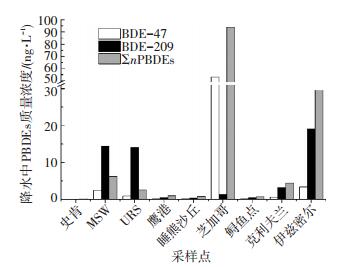
|
n为减去BDE-209的所有物质个数,从左至右n为9、8、8、7、7、7、7、7、7,MSW为瑞士马尔默市政垃圾焚烧厂,URS为瑞士马尔默电子垃圾拆解地)[37, 52, 55-56] 图 1 国外雨水中PBDEs的质量浓度 Figure 1 Concentration of PBDEs in rain waters abroad |
由图 1可知,在芝加哥[37]雨水中的ΣnPBDEs(n为减去BDE-209 PBDEs组分数量)质量浓度达到最高,为95.3 ng·L-1,其次为伊兹密尔[55],质量浓度值为29.6 ng·L-1,质量浓度最低的为瑞士的史肯(隆德)[52],为0.21 ng·L-1.BDE-209质量浓度最高的地区为伊兹密尔[55],为19.1 ng·L-1.北美五大湖中鲟鱼点[37]降水中BDE-209质量浓度最低为0.4 ng·L-1,在克利夫兰[37]降水中BDE-209是最丰富的物质.在瑞士马尔默的市政垃圾焚烧厂与电子垃圾拆解地降水中[56]中BDE-209的质量浓度相差不大,分别为14.1与14.4 ng·L-1,但ΣnPBDEs质量浓度相差很大,市政垃圾焚烧厂(MSW)比电子垃圾拆解地(URS)的降水中ΣnPBDEs质量浓度高3.7 ng·L-1,更比史肯的城区高出5.99 ng·L-1.BDE-47质量浓度最高的地区为芝加哥(53 ng·L-1)[37].最低为鲟鱼点0.09 ng·L-1[37].与其他地点不同的是,BDE-47在芝加哥的湿沉降中质量浓度大于BDE-209,这可能与当地排放的PBDEs组成有关.
图 2为广州、东莞、顺德雨水颗粒相以及溶解相中ΣPBDEs、BDE-209以及BDE-47的质量浓度水平[53].在雨水中,PBDEs单体由于其物理化学性质不同,在雨水中溶解相与颗粒相中的分布也不相同.在广州、东莞以及顺德[53]雨水中,颗粒相中的ΣPBDEs、BDE-209以及BDE-47的质量浓度高于溶解相.广州雨水颗粒相和溶解相中ΣPBDEs、BDE-209以及BDE-47质量浓度高于其他2个城市,其颗粒相质量浓度分别为61.594、58.093、0.066 ng·L-1,其溶解相质量浓度分别为0.133、0.092、0.012 ng·L-1[53].雨水颗粒相ΣPBDEs质量浓度最低的地区为东莞(8.898 ng·L-1)[53],BDE-209质量浓度最低的地区为东莞(87.627 ng·L-1)[53],BDE-47质量浓度最低的地区为顺德(0.025 ng·L-1)[53].在溶解相中ΣPBDEs与BDE-47质量浓度最低的地区为顺德,分别为0.080、0.005 ng·L-1[53],BDE-209质量浓度最低的地区为东莞(0.055 ng·L-1)[53].在东莞、广州和顺德3个城市降雨中,BDE-209在颗粒相与溶解相质量浓度的比值分别为139、178、631,远高于BDE-47 (7、5、5),是由于BDE-209的辛醇-水分配系数大于BDE-47,更易吸附在颗粒物表面.湿沉降中溶解相与颗粒相中ΣPBDEs与BDE-209质量浓度相差很大,可能是由于PBDEs单体的辛醇-水分配系数较大,其更易吸附在颗粒物表面.
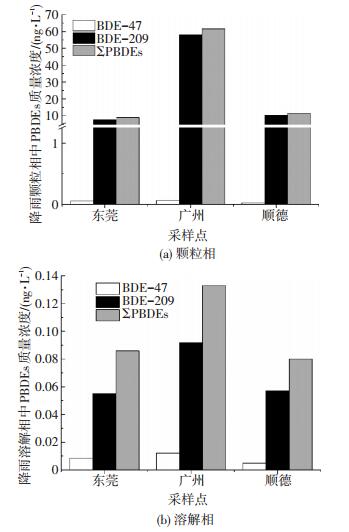
|
图 2 国内珠江三角洲一带雨水中颗粒相和溶解相PBDEs质量浓度水平[53] Figure 2 Concentrations of PBDEs in dissolved phase in rain waters in the Pearl River Delta of China[53] |
在另一篇关于珠江三角洲的干湿沉降研究报道中,雨水溶解相中,三溴联苯醚到七溴联苯醚质量浓度范围为nd~0.108 ng·L-1,十溴联苯醚质量浓度范围为nd~1.040 ng·L-1,而PBDEs脱溴产物质量浓度为nd~0.625 ng·L-1.在雨水颗粒相中,三溴联苯醚到七溴联苯醚质量浓度范围为nd~0.184 ng·L-1,PBDEs代谢物质量浓度范围为nd~1.230 ng·L-1,十溴联苯醚质量浓度范围为0.198~65.000 ng·L-1[57].在雨水颗粒物中,BDE-209的质量浓度为2 280 ng·g-1[57],其他PBDEs的颗粒物总质量浓度为185 ng·g-1[57].
此外,在2012年报道的法国的干湿沉降以及总沉降中,PBDEs单体在0.04~7.69 ng·L-1[58].在伊兹密尔,BDE-209为大气中、降水中以及土壤中含量高的单体[59].
2.1.2 湿沉降中PBDEs组成特征由于使用量与物理化学性质的不同,PBDEs在湿沉降中的组成特征也不尽相同,图 3描述了各采样点PBDEs单体组成.BDE-209在降水中贡献率最大,贡献率在75%以上,在电子垃圾拆解地以及市政垃圾焚烧厂,对降水贡献率较高的另外一种物质为BDE-47.在珠江三角洲雨水颗粒相中BDE-209所占比率的范围在87%(东莞)~94%(广州),在雨水溶解相中BDE-209所占比率范围为65%(东莞)~71%(顺德)[53].
2.2 PBDEs沉降通量 2.2.1 PBDEs干沉降通量的研究干沉降分为颗粒干沉降与气相干沉降,目前对于气相干沉降通量进行单独报道的文章较少.干沉降通量可以通过监测数据也可以通过式(1)、(2) 进行模拟计算.
图 4为不同采样点PBDEs组分干沉降通量,ΣPBDEs干沉降通量最高的地区为珠江三角洲(320 ng·m-2·d-1)[50],最低地区为瑞士的电子垃圾拆解地(URS)[56](7.00 ng·m-2·d-1).BDE-209干沉降通量最高地区为瑞士的市政垃圾焚烧厂(MSW)[56](77.10 ng·m-2·d-1),最低的地区为法国巴黎[58](1.14 ng·m-2·d-1).
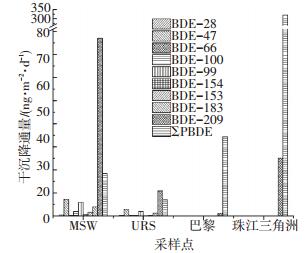
|
图 4 不同采样点PBDEs单体干沉降通量[56, 58] Figure 4 Dry deposition of different PBDEs congeners in different studies[56, 58] |
Zhang等运用干沉降模型以及监测数据模拟计算广州市内不同高度处的干沉降通量[60],结果如图 5所示.在不同采样高度和不同月份的干沉降通量中,BDE-209干沉降通量最大.12月份BDE-209的干沉降通量(121 ng·m-2·d-1)要高于8月份BDE-209干沉降通量(85.7 ng·m-2·d-1)约30 ng·m-2·d-1.8月份BDE-47、BDE-99、BDE-183的干沉降通量高于12月份3种组分的干沉降通量约1 ng·m-2·d-1.除BDE-209外,BDE-207为干沉降通量最大的单体,8月份100 m、150 m, 12月份100 m、150 m,BDE-207的干沉降通量分别为88.6、82.7、119、122 ng·m-2·d-1.
图 6为伊兹密尔在城市以及郊区的干沉降通量,ΣPBDEs干沉降通量分别为128.8和67.6 ng·m-2·d-1[59],在城区以及郊区[59],干沉降通量最低的单体分别为BDE-28与BDE-154,沉降通量分别为2.2和1.8 ng·m-2·d-1.在城区以及郊区,干沉降通量最高的单体均为BDE-209,分别为107.5和49.4 ng·m-2·d-1,对城区以及郊区PBDEs的干沉降通量分别贡献76%和49% [59].
关于气相干沉降通量,有报道称,大气气相干沉降去除大气中的PBDEs可以忽略[61],而颗粒干沉降为大气干沉降去除PBDEs的主要途径.在广州运用模型对大气颗粒干沉降通量与气相干沉降通量分别进行模拟计算时,二者之间相差3~4个数量级[60].
意大利布莱特沿海地区Mazzorbetto Island的采样表明,在每个采样期间,BDE-47、BDE-99和BDE-183的干沉降通量对干沉降贡献为80%左右,接近其湿沉降通量贡献率78%~89%[62].
PBDEs每种组分对PBDEs总沉降通量的贡献率不相同.在广州以及香港,BDE-209对PBDEs总沉降通量的贡献率在82%~99.9%.在广州,BDE-47、-99以及-183的平均贡献率分别为1.1%、1.5%及0.6%,都分别大于其在香港的贡献率;在香港,3种单体的贡献率分别为0.4%、0.3%及0.2%[63].
2.2.2 PBDEs湿沉降通量图 7为国外研究中采样点湿沉降通量,ΣPBDEs湿沉降通量最高的地区为广州[64](130 ng·m-2·d-1),其次为瑞士马尔默的市政垃圾焚烧厂[56](21.6 ng·m-2·d-1),ΣPBDEs湿沉降通量最低的地区为瑞士的史肯[52](1 ng·m-2·d-1),其次为意大利特兰托[65](1.16 ng·m-2·d-1).此外,瑞士市政垃圾焚烧厂[56]BDE-47湿沉降通量最高(9.3 ng·m-2·d-1),BDE-47湿沉降通量最低的地区为东京[66](1.44 ng·m-2·d-1).在瑞士市政垃圾焚烧厂,每种单体的湿沉降通量均高于电子垃圾拆解地.市政垃圾焚烧厂BDE-209湿沉降通量最高为63.8 ng·m-2·d-1.
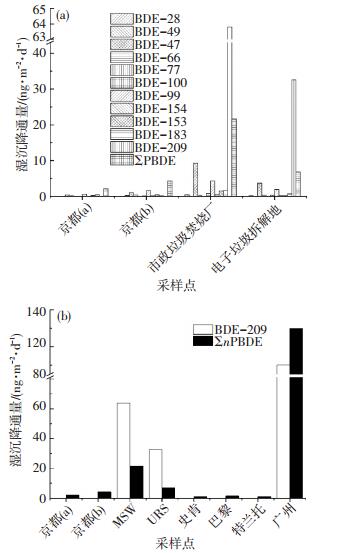
|
京都(a)为京都湿沉降中颗粒相的沉降通量,京都(b)为京都湿沉降中溶解相的沉降通量.n为减去BDE-209所研究的物质的数量,从左至右n为8、8、8、8、8、8, n+1=14、20)[56, 66] 图 7 国外湿沉降通量 Figure 7 Wet deposition flux at different sites abroad |
在湿沉降通量中颗粒相与溶解相的研究中,日本京都的研究表明[66],除BDE-183外,溶解相中PBDEs单体沉降通量均高于颗粒相,可能由于空气中颗粒物含量较少.
在珠江三角洲电子垃圾拆解地,PBDEs单体湿沉降通量范围为4.7 (BDE-28)~1 960 ng·m-2·d-1 (BDE-209),平均总沉降通量为3 000 ng·m-2·d-1[39].BDE-209对沉降通量的贡献最大.
Li Jun等报道的2003年12月—2004年11月珠江三角洲周围15个采样点的沉降样品中,BDE-209的平均沉降通量为32.6~1 970 μg·m-2·a-1,珠江三角洲的沉降通量达13 400 kg·a-1, 香港平均沉降通量为93 kg·a-1.BDE-209在珠江三角洲中心区域沉降通量相对较高,沿海地区的沉降通量相对较低.按照沉降通量的高低,珠江三角洲可分为3个群组:高质量浓度区域,广州(中山大学、广州东北部城区、广州东部城区)、顺德、中山(830 ~ 1 970 μg·m-2·a-1);中质量浓度区域, 清远、深圳和南海区郊区(220~390 μg·m-2 ·a-1);低质量浓度沿海地区(33~130 μg·m-2·a-1)[67].由于顺德市是电子垃圾以及塑料等的运营拆解地[68],导致广州、东莞和深圳的土壤和沉积物中沉积了大量的PBDEs[69].在冬季,中山是东莞的下风向,因此,珠江三角洲整个区域在冬季大气以及干湿沉降中的PBDEs质量浓度很高[67].
2.2.3 PBDEs干、湿沉降通量对比通过对比图 7与图 4,瑞士马尔默电子垃圾拆解地(URS)与市政垃圾焚烧厂(MSW)的干湿沉降通量,除BDE-209外,每种PBDEs单体的干沉降通量以及湿沉降通量差别不大,在MSW与URS BDE-209的干、湿沉降通量分别相差13.3与-21.7 ng·m-2·d-1.
如图 8所示为伊兹密尔的沉降通量[59],湿沉降通量、干颗粒沉降通量以及气相沉降通量中,BDE-209沉降通量最高,分别为12 379、18 614、3 100 ng·m-2·a-1.BDE-28在沉降通量中最低,分别为274、740、150 ng·m-2·a-1.在所研究的几种PBDEs单体中,与湿沉降通量、气相沉降通量相比干颗粒沉降通量最高.而在伊兹密尔郊区,总沉降通量为18.74 μg·m-2·a-1[55].
不同地区,由于其气象条件等因素的不同,其干、湿沉降通量的差别不同.
2.2.4 PBDEs总沉降沉降通量国内外PBDEs由于降雨引起的总沉降沉降通量如图 9所示.BDE-209平均总沉降沉降通量最高的地区为广州(城区)[63](2 220 ng·m-2·d-1),其次为香港(城区)[63](259 ng·m-2·d-1),ΣPBDEs总沉降沉降通量最高的地区为广州(城区)(91.7 ng·m-2·d-1),最低的地区为德南洞[70](1.5 ng·m-2·d-1).

|
n为减去BDE-209所研究的物质的数量,从左至右n为8、19、19、19、19、9、8、9、9、9、8、9、9、7 图 9 降雨引起的PBDEs总沉降沉降通量[58, 62-63, 66, 70-72] Figure 9 Deposition flux of BULK deposition in the rain[58, 62-63, 66, 70-72] |
目前,国内外关于降雪中PBDEs的研究主要集中在地表面上雪层中PBDEs[73-75]的年际变化,关于降雪中PBDEs研究较少.
图 10为北极阿比斯库以及在亚北极Krycklan[76]由于降雪引起的PBDEs总沉降沉降通量.可以看出,PBDEs在Krycklan总沉降沉降通量为20 ng·m-2·d-1,高于阿比斯库的总沉降沉降通量(7.3 ng·m-2·d-1),这可能是由于在亚北极人类活动要比北极频繁.
2.2.5 PBDEs沉降通量的季节变化在关于沉降通量季节变化的研究中,韩国沿海地区大溶洞和沃尔普[70]冬季的PBDEs颗粒干沉降通量大于夏季.珠江三角洲干季颗粒干沉降通量水平高于湿季颗粒干沉降总通量的1.7~2.0倍[53].对于BDE-209,湿季湿沉降通量比干季湿沉降通量沉降通量高[67].广州和香港沉降通量冬季高于夏季,在广州干湿沉降的季节变化十分明显,而且在雾霾期间BDE-209的沉降通量达到最高[63].在东江流域[72]与珠江三角洲[77]PBDEs总沉降沉降通量夏季高于冬季.
2.3 PBDEs湿沉降清除率研究降水对大气中气相物质的去除效果取决于化合物的物理化学性质以及环境温度[43].在0 ℃时,降雨比降雪对大气中气相物质的清除率高,主要是因为雪吸附小分子的能力小于雨滴,而雪对大分子以及非极性分子的去除效果更好[43].当温度低于-10 ℃时,降雪比降雨对大气中气相物质的清除效果好[43].在已有PBDEs的干湿沉降研究中,PBDEs的清除率数量级从103到108[63].
在法国巴黎湿沉降平均清除率为1.5×105,BDE-153与BDE-209的清除率分别为4×104及5×105[58].
在中国的广州、顺德、东莞关于湿沉降对大气中PBDEs的清除效率研究时,15种物质总的湿沉降清除率为4.1×104,从三溴联苯醚到十溴联苯醚的清除率范围为4.5×103~5.9×104.在顺德,15种物质总的清除率为1.7×104,从三溴联苯醚到十溴联苯醚的清除率范围为1.7×103~1.8×104[53],十溴联苯醚是湿沉降去除效果最好的物质,与理论上的清除率存在很大差异[63].而在广州和香港的干湿沉降研究中, BDE-47、BDE-99和BDE-209的平均清除率量级可达105,分别为1.1×105、3.1×105及5.1×105,在降水量多的季节与降水量少的季节的湿沉降清除率范围分别为7.7×103~2.8×107、7.8×103~2.6×107、4.2×104~`3.5×108[63].
在特殊工业区,如瑞士马尔默的市政垃圾焚烧厂以及电子垃圾拆解地[56]的湿沉降对每种物质的清除率不同,最高可达106.如图 11所示,在市政垃圾焚烧厂以及电子垃圾拆解地中降水对每种物质的清除率差别很大,总体来说,电子垃圾拆解地中降水对空气中物质清除率高于市政垃圾焚烧厂[56],但是市政垃圾焚烧厂降水对BDE-47清除率要高于电子垃圾拆解地[56].整体水平均高于模型运算中的数值100 000[43]和200 000[41],可能是由于市政垃圾焚烧厂与电子垃圾拆解地大气中PBDEs含量较高,降雨对大气中PBDEs的清除效果较为明显.
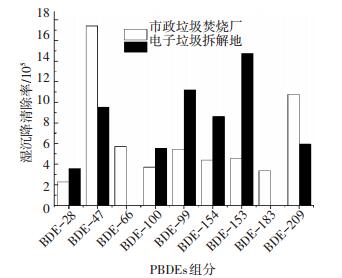
|
图 11 马尔默采样点降水对每种单体的清除率[56] Figure 11 Washout ratio of wet deposition for PBDEs congeners in Malmo[56] |
干沉降分为颗粒干沉降与气相干沉降,颗粒干沉降为大气干沉降去除PBDEs的主要途径,PBDEs的干沉降速率估计方法很多,可以通过模型进行模拟,也可以用监测数据进行计算.
图 12为不同采样点9种PBDEs单体干沉降速率,可以看出,BDE-209干沉降速率最高的地区为马尔默电子垃圾拆解地(48.9 cm·s-1)[56];BDE-209干沉降速率最低的地区为广州、香港(0.28 cm·s-1)[63],且每种单体之间的干沉降速率相差不大,不同种类物质干沉降速率相差也不大,PAHs:(0.45±0.35)、(0.74±0.23) cm·s-1[78].在法国巴黎[58],PBDEs干沉降速率最高的单体为BDE-209(1.1 cm·s-1),与PBDEs其他单体干沉降速率相差不大.

|
图 12 不同采样点9种PBDEs单体干沉降速率[56, 58-59, 63] Figure 12 Dry deposition velocities of 9 PBDEs congeners at different sampling sites[56, 58-59, 63] |
在土耳其的伊兹密尔,城区每种物质干沉降速率要高于郊区相应物质[59].城区以及郊区干沉降速率最高的物质为BDE-28,分别为11.5、7.8 cm·s-1,城区以及郊区干沉降速率最低的物质为BDE209、BDE-154, 分别为3.9、2.8 cm·s-1.
在广州、顺德和东莞关于干沉降速率的研究中,利用在瑞典马尔默报道的干沉降速率0.4~49 cm·s-1[37]进行干沉降速率的敏感性分析,结果表明:干沉降通量对干沉降速率十分敏感,说明干沉降速率对干沉降通量的影响很大[37].
在珠江三角洲颗粒物的干沉降速率研究中,不同月份、不同高度处采集样品模拟计算出的目标物干沉降速率数量级相同,数值相差不大,范围在0.12~0.28 cm·s-1[60].在珠江三角洲电子垃圾拆解地,运用分粒级方法对干沉降速率进行模拟,干沉降速率为0.23~0.29 cm·s-1[39],不同采样方法模拟预测的干沉降速率相差不大[63].
在特殊地区,通过监测得到的干沉降速率与通过模型计算的干沉降速率相差很大,特殊地区如市政垃圾焚烧地以及电子垃圾拆解的干沉降速率为0.4~49 cm·s-1[56].干沉降速率的数量级一般相差不大,但是在市政垃圾焚烧厂以及电子垃圾拆解地等特殊采样地的干沉降速率跨度较大.在一般城区以及郊区中干沉降速率监测值小于模型应用中干沉降速率0.1 m·s-1[41],但是对于特殊工业区如市政垃圾焚烧地以及电子垃圾拆解的干沉降速率[56]则有可能大于模型应用中干沉降速率0.1 m·s-1[43].
2.5 化合物分配空间图对PBDEs干湿沉降预测分析 2.5.1 各相的分配如图 13所示,由log KRain/Air(雨相-气相分配系数)和logKParticle/Air (颗粒相-气相分配系数)构成的两维CPSM中的3个相区:左上角粉红色虚线所围成的气相为主(>50%)区域,右上角绿色虚线所围成的颗粒相为主(>50%)区域,左下角蓝色虚线所围成的雨相(包括雨水中的溶解相和颗粒相)为主(>50%)的区域.图 13还描述了8种PBDEs单体(BDE-28、-47、-99、-100、153、-154、-183以及-209) 于CPSM中在温度为0~50 ℃内的位置.轻分子量单体主要位于气相为主区域,而重分子量单体则位于颗粒相为主区域,其中BDE-28则完全处于气相为主区域,而BDE-209则完全处于颗粒相为主区域.由于这些化合物的雨相-气相分配系数较小,这些单体不能进入雨相为主的区域.即这些单体进入雨相的量小于50%.在降雨时化合物在各相的分配决定该化合物是否和有多少被降雨所去除.

|
图 13 PBDEs单体在大气气相、大气颗粒相、降雨溶解相和颗粒相中的分配 Figure 13 The distribution of the different PBDEs congener in gas phase, particle phase and dissolved phase and particle phase |
由图 13可知,BDE-47主要分配于大气气相,与五大湖[37]的报道中BDE-47是睡熊沙丘、芝加哥、鲟鱼点和鹰港大气气相中最为丰富的物质相吻合.
2.5.2 各相的沉降CPSM也可用来对PBDEs的干湿沉降进行分析,结果如图 14所示.与图 13对应,图 14显示了CPSM中3种类型的沉降:气相干沉降为主(>50%)的位于左上角粉红色虚线所围成的区域,气相湿沉降为主(>50%)的位于左下角的蓝色虚线所围成的区域,以及颗粒相干湿沉降为主(>50%)的位于右上角绿色虚线所围成的区域.图 14还描述了8种PBDE单体(BDE-28、-47、-99、-100、153、-154、-183以及-209) 于CPSM中在温度为0~50 ℃内的位置.重分子量单体BDE-153、-154、-183及-209处于颗粒相干湿沉降为主的区域,而轻分子量单体BDE-28和-47都处于气相干沉降为主的区域.轻分子量单体(比如BDE-28) 以气相的干沉降为主,而重分子量单体(比如BDE-209) 则以颗粒相的干湿沉降为主.

|
图 14 PBDEs单体现在气相干沉降、颗粒相干沉降与湿沉降、气相湿沉降中沉降分配 Figure 14 The distribution of the different PBDEs congener in gas phase dry deposition, particle phase dry deposition and particle phase wet deposition, gas phase wet deposition |
由图 14可知,BDE-47气相湿沉降应该略大于颗粒相沉降,结合图 1、13和14,BDE-47在空气和沉降之间的浓度关系进一步说明湿沉降是去除大气中污染物的有效方式[37].而由图 14,对于BDE-209在颗粒湿沉降相分配比率大于在气相湿沉降相分配比率,与图 2珠江三角洲PBDEs湿沉降颗粒相浓度大于溶解相浓度、图 8伊兹密尔干颗粒沉降通量最高的结果很好匹配.对于BDE-209,其分配于颗粒干沉降与颗粒湿沉降中比率大于其他单体,与报道中图 4、5和6的结果很好匹配.所以,CPSM可以很好地预测PBDEs在气相干沉降、气相湿沉降以及颗粒相的干沉降和湿沉降溶解相和湿沉降颗粒相中的分配比率.
3 总结与展望近年来,关于PBDEs在不同地区和不同季节干湿沉降的浓度、沉降通量、清除率的研究以及干沉降速率方面的研究已经取得一定进展,但是缺乏PBDEs气相干沉降的研究,以及湿沉降中溶解相与颗粒相之间的分配关系研究;此外,对干湿沉降引起的PBDEs在大气与土壤或水体之间交换的相关研究较少.
未来应深入研究干湿沉降中颗粒物的粒径分布与大气中颗粒物粒径分布之间的关系、干湿沉降与温度之间的关系、湿沉降中颗粒相与溶解相PBDEs之间的分配关系、PBDEs干湿沉降与PBDEs物理化学性质之间的关系.
| [1] |
黄金鑫, 令狐文声. PBDEs的环境污染现状及其分析方法的研究进展[J].
山东化学, 2014, 43(8): 58-60.
HUANG Jinxin, LINGHU Wensheng. The environmental pollution situation and analytical method of PBDEs[J]. Shandong Chemical, 2014, 43(8): 58-60. |
| [2] |
张清, 刘希涛, 焦颖. 羟基取代和甲氧基取代多溴联苯醚的存在特征和源解析研究进展[J].
生态环境学报, 2011, 20(4): 773-778.
ZHANG Qing, LIU Xitao, JIAO Ying. Reviewed article: Hydroxyl replace and methoxy replace polybrominated diphenyl ether the existence of the characteristic and source analysis[J]. Journal of Ecological Environment, 2011, 20(4): 773-778. |
| [3] |
DE WIT C A, HERZKE D, VORKAMP K. Brominated flame retardants in the Arctic environment-trends and new candidates[J].
Science of the Total Environment, 2010, 408(15): 2885-2918.
DOI: 10.1016/j.scitotenv.2009.08.037 |
| [4] |
QIU X, ZHU T, HU J. Polybrominated diphenyl ethers (PBDEs) and other flame retardants in the atmosphere and water from Taihu Lake, East China[J].
Chemosphere, 2010, 80(10): 1207-1212.
DOI: 10.1016/j.chemosphere.2010.06.013 |
| [5] |
金军, 王英, 唐志伟, 等. 莱州湾地区土壤及底泥中多溴联苯醚水平及其分布[J].
环境科学学报, 2008, 28(7): 1463-1468.
JIN Jun, WANG Ying, TANG Zhiwei, et al. The polybrominated diphenyl ether levels and their distribution in soil and sediment in laizhou bay area[J]. Journal of Environmental Science, 2008, 28(7): 1463-1468. |
| [6] |
JULANDER A, WESTBERG H, ENGWALL M, et al. Distribution of brominated flame retardants in different dust fractions in air from an electronics recycling facility[J].
Science of the Total Environment, 2005, 350(1/2/3): 151-160.
|
| [7] |
HOH E, HITES R A. Brominated flame retardants in the atmosphere of the East-Central United States[J].
Environmental Science & Technology, 2005, 39(20): 7794-7802.
|
| [8] |
SHEN Li, WANIA F, LEI Y D. Polychlorinated biphenyls and poIybrominated diphenyl ethers in the North American atmosphere[J].
Environmental Pollution, 2006, 144: 434-444.
DOI: 10.1016/j.envpol.2005.12.054 |
| [9] |
LI Wenlong, HUO Chunyan, LIU Liyan, et al. Multi-year air monitoring of legacy and current-use brominated flame retardants in an urban center in northeastern China[J].
Science of the Total Environment, 2016, 571: 633-642.
DOI: 10.1016/j.scitotenv.2016.07.031 |
| [10] |
LI Wenlong, QI Hong, MA Wanli, et al. Brominated flame retardants in Chinese air before and after the phase out of polybrominated diphenyl ethers[J].
Atmospheric Environment, 2015, 117: 156-161.
DOI: 10.1016/j.atmosenv.2015.07.021 |
| [11] |
ZHU Yunjuan, SUN Dan, YANG N E, et al. Temporal and spatial distributions of PBDEs in atmosphere at Shanghai rural regions, China[J].
Environ Sci Pollut Res Int, 2017.
|
| [12] |
YANG Meng, JIA Hongliang, MA Wanli, et al. Levels, compositions, and gas-particle partitioning of polybrominated diphenyl ethers and dechlorane plus in air in a Chinese northeastern city[J].
Atmospheric Environment, 2012, 55: 73-79.
DOI: 10.1016/j.atmosenv.2012.03.040 |
| [13] |
LI Yifan, QIAO Lina, REN Nanqi, et al. Decabrominated diphenyl ethers (BDE-209) in Chinese and global air: Levels, gas/particle partitioning, and long-range transport: Is long-range transport of BDE-209 really governed by the movement of particles?[J].
Environmental Science & Technology, 2017, 51(2): 1035-1042.
|
| [14] |
李英明, 江桂斌, 王亚韡, 等. 电子垃圾拆解地大气中二噁英, 多氯联苯, 多溴联苯醚的污染水平及相分配规律[J].
科学通报, 2008, 53: 165-171.
LI Yingming, JINAG Guibin, WANG Yawei, et al. The contamination level and phase distribution rule of dioxin, PCBs, PBDEs in E-waste dismantling[J]. Chinese Science Bulletin, 2008, 53: 165-171. DOI: 10.3321/j.issn:0023-074X.2008.02.006 |
| [15] |
CHEN Duohong, BI Xinhui, ZHAO Jinping, et al. Pollution characterization and diurnal variation of PBDEs in the atmosphere of an E-waste dismantling region[J].
Environmental Pollution, 2009, 157(3): 1051-1057.
DOI: 10.1016/j.envpol.2008.06.005 |
| [16] |
王俊, 张干, 李向东, 等. 珠江三角洲地区大气中多溴联苯醚的被动采样观测[J].
中国环境科学, 2007, 27: 10-13.
WANG Jun, ZAHGN Gan, LI Xiangdong, et al. Monitoring of polybrominated diphenyl ethers in the atmosphere of the Pearl River Delta using PUF-passive air sampler[J]. China Environmental Science, 2007, 27: 10-13. DOI: 10.3321/j.issn:1000-6923.2007.01.004 |
| [17] |
HARRD S, HUNTER S. Concentrations of polybrominated diphenyl ethers in air and soil on a rural-urban transect across a major UK conurbation[J].
Environmental Science & Technology, 2006, 40(15): 4548-4553.
|
| [18] |
WANG Pu, ZHANG Qinghua, WANG Yawei, et al. Altitude dependence of polychlorinated biphenyls (PCBs) and polybrominated diphenyl ethers (PBDEs) in surface soil from Tibetan Plateau, China[J].
Chemosphere, 2009, 76(11): 1498-1504.
DOI: 10.1016/j.chemosphere.2009.06.045 |
| [19] |
JIANG Yufeng, WANG Xuetong, ZHU Kun, et al. Occurrence, compositional profiles and possible sources of polybrominated diphenyl ethers in urban soils of Shanghai, China[J].
Chemosphere, 2010, 80(2): 131-136.
DOI: 10.1016/j.chemosphere.2010.04.007 |
| [20] |
WANG Xu, REN Nanqi, QI Hong, et al. Levels and distribution of brominated flame retardants in the soil of Harbin in China[J].
Journal of Environmental Sciences, 2009, 21(11): 1541-1546.
DOI: 10.1016/S1001-0742(08)62452-3 |
| [21] |
LI Wenlong, LIU Liyan, ZHANG Zifeng, et al. Brominated flame retardants in the surrounding soil of two manufacturing plants in China: Occurrence, composition profiles and spatial distribution[J].
Environmental Pollution, 2016, 213: 1-7.
DOI: 10.1016/j.envpol.2016.01.092 |
| [22] |
邹梦瑶, 龚剑, 冉勇. 珠江三角洲流域土壤多溴联苯醚(PBDEs)的分布及环境行为[J].
生态环境学报, 2009, 18: 122-127.
ZOU Mengyao, GONG Jian, RAN Yong. The distribution and the environmental fate of polybrominated diphenyl ethers in watershed soils of Pearl River Delta[J]. Ecology and Environment Sciences, 2009, 18: 122-127. DOI: 10.3969/j.issn.1674-5906.2009.01.024 |
| [23] |
ALLCHIN C R, LAW R J, MORRIS S. Polybrominated diphenylethers in sediments and biota downstream of potential sources in the UK[J].
Environmental Pollution, 1999, 105(2): 197-207.
DOI: 10.1016/S0269-7491(98)00219-X |
| [24] |
周鹏, 李匡飞, 于慧娟, 等. 东海沉积物中多溴联苯醚的分布特征研究[J].
中国环境科学, 2016, 36(1): 149-156.
ZHOU Peng, LI Kuangfei, YU Huijuan, et al. The distribution of polybrominated piphenyl rther in the sediment of East China Sea[J]. China Environmental Science, 2016, 36(1): 149-156. |
| [25] |
娄素芳, 王欣欣, 姜子岸, 等. 贵屿表层土壤中多溴联苯醚的水平与儿童健康风险[J].
上海大学学报(自然科学版), 2016, 22(2): 141-150.
LOU Sufang, WANG Xinxin, JIANG Zian., et al. Levals of polybrominated diphenyl ethers in the surface soil Guiyu and the associated health risk to children[J]. Journal of Shanghai University(Natural Science), 2016, 22(2): 141-150. |
| [26] |
孟博, 刘丽艳, 马万里, 等. 垃圾焚烧发电厂周边土壤多溴联苯醚污染特征及来源解析[J].
环境科学研究, 2015, 28(5): 775-781.
MENG Bo, LIU Liyan, MA Wanli, et al. Characteristic and possible source polybrominated diphenyl ethers in soils in vicinity of municipal solid wasted incineration power plants[J]. Research of Environmental Sciences, 2015, 28(5): 775-781. |
| [27] |
LI Wenlong, MA Wanli, JIA Hongliang, et al. Polybrominated diphenyl ethers (PBDEs) in surface soils across five asian countries: Levels, spatial distribution, and source contribution[J].
Environmental Science & Technology, 2016, 50(23): 12779-12788.
|
| [28] |
LIWenlong, MAWanli, JIAHongliang, 等. Levels and distribution of polybrominated diphenyl ethers in plant, shellfish and sediment samples from Laizhou Bay in China[J].
Chemosphere, 2008, 71(6): 1043-1050.
|
| [29] |
BI Xinhui, QU Weiyue, SHEN Guoying, et al. Polybrominated diphenyl ethers in South China maternal and fetal blood and breast milk[J].
Environmental Pollution, 2006, 144(3): 1024-1030.
DOI: 10.1016/j.envpol.2005.12.056 |
| [30] |
AGRELL C, LARSSON P, OKLA L, et al. PCB congeners in precipitation, wash out ratios and depositional fluxes within the Baltic Sea region, Europe[J].
Atmospheric Environment, 2002, 36(2): 371-383.
DOI: 10.1016/S1352-2310(01)00228-X |
| [31] |
GUNINDI M, TASDEMIR Y. Atmospheric polychlorinated biphenyl (PCB) inputs to a coastal city near the marmara sea[J].
Marine Pollution Bulletin, 2010, 60(12): 2242-2250.
DOI: 10.1016/j.marpolbul.2010.08.012 |
| [32] |
毕春娟, 陈振楼, 吕金刚, 等. 上海市大气干湿沉降中PAHs与PCBs变化特征与沉降通量[C]//地理学核心问题与主线-中国地理学会2011年学术年会暨中国科学院新疆生态与地理研究所建所五十年庆典. 2011.
BI Chunjuan, CHEN Zhenlou, LV Jin'gang, et al. PAHs and PCBs wet deposition variation characteristics and fluxes in Shanghai atmosphere[C]//The Annual Meeting and Academic Establishment of the Xinjiang Institute of Ecology and Geography, Chinese Academy of Sciences of Fifty Years Celebration, Geographical Society of China in 2011. 2011. |
| [33] |
叶兆贤, 张干, 邹世春, 等. 珠三角大气多环芳(PAHs)的干湿沉降[J].
中山大学学报(自然科学版), 2005, 44(1): 49-52.
YE Zhaoxian, ZHANG Gan, ZOU Shichun, et al. Dry and wet depositions of atmospheric PAHs in the Pearl River Delta region[J]. Journal of Sun Yatsen University(Natural Science Edition), 2005, 44(1): 49-52. |
| [34] |
赵靖宇, 王文涛, 王伟, 等. 华北地区城镇多环芳烃干沉降特征[J].
环境科学学报, 2009, 29(7): 1358-1362.
ZHAO Jingyu, WANG Wentao, WANG Wei, et al. Dry deposition of polycyclic aromatic hydrocarbons in cities and towns of Northern Chinese[J]. Acta Scienctiae Circumstantiae, 2009, 29(7): 1358-1362. |
| [35] |
苗迎, 孔祥胜. 南宁市多环境介质中多环芳烃分布特征[J].
环境科学, 2016, 37(11): 4333-4340.
MIAO Ying, KONG Xiangsheng. Distribution characteristics of polycylic aromatic hydrocarbons in environmental media in Nanning City[J]. Environmental Science, 2016, 37(11): 4333-4340. |
| [36] |
袁宏林, 范雅文, 王晓昌. 西安市城区持久性有机污染物的干湿沉降[J].
环境工程学报, 2016, 10(3): 1358-1364.
YUAN Honglin, FAN Yawen, WANG Xiaochang. Persistent organic polluants in dry and wet atmosphere deposition of Xi'an[J]. Chinese Journal of Environmenal Engineering, 2016, 10(3): 1358-1364. |
| [37] |
VENIER M, HITES R A. Atmospheric deposition of PBDEs to the Great Lakes featuring a Monte Carlo analysis of errors[J].
Environmental Science & Technology, 2008, 42(24): 9058-9064.
|
| [38] |
ZOU Mengyao, RAN Yong, GONG Jian, et al. Polybrominated diphenyl ethers in watershed soils of the Pearl River Delta, China: Occurrence, inventory, and fate[J].
Environmental Science & Technology, 2007, 41(24): 8262-8267.
|
| [39] |
LUO Pei, NI Honggang, BAO Lianjun, et al. Size distribution of airborne particle-bound polybrominated diphenyl ethers and its implications for dry and wet deposition[J].
Environmental Science & Technology, 2014, 48(23): 13793-13799.
|
| [40] |
MANDALAKIS M, BESIS A, STEPHANOU E G. Particle-size distribution and gas/particle partitioning of atmospheric polybrominated diphenyl ethers in urban areas of Greece[J].
Environmental Pollution, 2009, 157(4): 1227-1233.
DOI: 10.1016/j.envpol.2008.12.010 |
| [41] |
MACKAY D.
Multimedia environmental models: The fugacity approach[M]. 2 nd ed. Crc Press, 2001: 97.
|
| [42] |
EISENREICH S J, LOONEY B B, THORNTON J D. Airborne organic contaminants in the Great Lakes ecosystem[J].
Environmental Science & Technology, 1981, 15(1): 30-38.
|
| [43] |
LEI Y D, WANIA F. Is rain or snow a more efficient scavenger of organic chemicals?[J].
Atmospheric Environment, 2004, 38(22): 3557-3571.
DOI: 10.1016/j.atmosenv.2004.03.039 |
| [44] |
FRANZ T P, EISENREICH S J. Snow scavenging of polychlorinated biphenyls and polycyclic aromatic hydrocarbons in Minnesota[J].
Environmental Science & Technology, 1998, 32(12): 1771-1778.
|
| [45] |
LIGOCKI M P, LEUENBERUER C, PANKOW J F. Trace organic compounds in rain—Ⅱ.Gas scavenging of neutral organic compounds[J].
Atmospheric Environment, 1985, 19(10): 1609-1617.
DOI: 10.1016/0004-6981(85)90213-6 |
| [46] |
LIGOCKI M P, LEUENBERGER C, PANKOW J F. Trace organic compounds in rain—Ⅲ. Particle scavenging of neutral organic compounds[J].
Atmospheric Environment, 1985, 19(10): 1619-1626.
DOI: 10.1016/0004-6981(85)90214-8 |
| [47] |
GOSS K U. Adsorption of organic vapors on polar mineral surfaces and on a bulk water surface: Development of an empirical predictive model[J].
Environmental Science & Technology, 1994, 28(4): 640-645.
|
| [48] |
VALSARAJ K T, THOMA G J, REIBLE D D, et al. On the enrichment of hydrophobic organic compounds in fog droplets[J].
Atmospheric Environment Part A General Topics, 1993, 27(2): 203-210.
DOI: 10.1016/0960-1686(93)90351-X |
| [49] |
ROTH C M, GOSS K U, SCHWARZENBACH R P. Adsorption of a diverse set of organic vapors on the bulk water surface[J].
Journal of Colloid and Interface Science, 2002, 252(1): 21-30.
DOI: 10.1006/jcis.2002.8446 |
| [50] |
PANKOW J F. Review and comparative analysis of the theories on partitioning between the gas and aerosol particulate phases in the atmosphere[J].
Atmospheric Environment, 1987, 21(11): 2275-2283.
DOI: 10.1016/0004-6981(87)90363-5 |
| [51] |
BIDLEMAN T F. Atmospheric processes: Wet and dry deposition of organic compowzds are controlled by their vapor-particle partitioning[J].
Environmental Science & Technology, 1988, 22(4): 361-367.
|
| [52] |
TER SCHURE A F H, LARSSON P. Polybrominated diphenyl ethers in precipitation in Southern Sweden (Skane, Lund)[J].
Atmospheric Environment, 2002, 36(25): 4015-4022.
DOI: 10.1016/S1352-2310(02)00360-6 |
| [53] |
ZHANG Baozhong, GUAN Yufeng, LI Shaomeng, et al. Occurrence of polybrominated diphenyl ethers in air and precipitation of the Pearl River Delta, South China: Annual washout ratios and depositional rates[J].
Environmental Science & Technology, 2009, 43(24): 9142-9147.
|
| [54] |
肖丹辉, 朱淑贞, 祝凌燕. 天津市大气降尘中多溴联苯醚的沉降通量研究[C]//中国化学会学术年会环境化学分会场. 2008.
XIAO Danhui, ZHU Shuzhen, ZHU Lingyan. PBDEs dry deposition fluxes in Tianjin[C]//Chinese Chemical Society Academic Annual Meeting Environmental Chemistry at he Venue. 2008. |
| [55] |
CETIN B, ODABASI M, BAYRAM A. Wet deposition of persistent organic pollutants (POPs) in Izmir, Turkey[J].
Environmental Science and Pollution Research, 2016, 23(9): 9227-9236.
DOI: 10.1007/s11356-016-6183-6 |
| [56] |
TER SCHURE A F H, AGRELL C, BOKENSTRAND A, et al. Polybrominated diphenyl ethers at a solid waste incineration plant Ⅱ: Atmospheric deposition[J].
Atmospheric Environment, 2004, 38(30): 5149-5155.
DOI: 10.1016/j.atmosenv.2004.05.025 |
| [57] |
GUAN Yufeng, SOJINU O S S, LI Shaomeng, et al. Fate of polybrominated diphenyl ethers in the environment of the Pearl River Estuary, South China[J].
Environmental Pollution, 2009, 157(7): 2166-2172.
DOI: 10.1016/j.envpol.2009.02.006 |
| [58] |
TLILI K, LABADIE P, ALLIOT F, et al. Polybrominated diphenyl ether dynamics in ambient air and atmospheric bulk/wet deposition in downtown Paris (France)[J].
Water Air and Soil Pollution, 2012, 223(4): 1543-1553.
DOI: 10.1007/s11270-011-0963-x |
| [59] |
CETIN B, ODABASI M. Particle-phase dry deposition and air-soil gas-exchange of polybrominated diphenyl ethers (PBDEs) in Izmir, Turkey[J].
Environmental Science & Technology, 2007, 41(14): 4986-4992.
|
| [60] |
ZHANG Baozhong, ZHANG Kai, LI Shaomeng, et al. Size-dependent dry deposition of airborne polybrominated diphenyl ethers in urban Guangzhou, China[J].
Environmental Science & Technology, 2012, 46(13): 7207-7214.
|
| [61] |
TER SCHURE A F H, LARRSON P, AGRELL C, et al. Atmospheric transport of polybrominated diphenyl ethers and polychlorinated biphenyls to the Baltic Sea[J].
Environmental Science & Technology, 2004, 38(5): 1282-1287.
|
| [62] |
GAMBARO A, RADAELLI M, PIAZZA R, et al. Organic micropollutants in wet and dry depositions in the Venice Lagoon[J].
Chemosphere, 2009, 76(8): 1017-1022.
DOI: 10.1016/j.chemosphere.2009.04.063 |
| [63] |
LI Jun, ZHANG Gan, XU Yue, et al. Dry and wet particle deposition of polybrominated diphenyl ethers (PBDEs) in Guangzhou and Hong Kong, South China[J].
Journal of Environmental Monitoring, 2010, 12(9): 1730-1736.
DOI: 10.1039/c001526a |
| [64] |
LI Jun, ZHANG Gan, XU Yue, et al. Seasonal deposition fluxes and removal efficiency of atmospheric polybrominated diphenyl ethers in a large urban center: Importance of natural and anthropogenic factors[J].
Environmental Science & Technology, 2014, 48(19): 11196-11203.
|
| [65] |
ARGITIADIS E, RADA E C, VECCHIATO M, et al. Assessing the influence of local sources on POPs in atmospheric depositions and sediments near Trento (Italy)[J].
Atmospheric Environment, 2014, 98: 32-40.
DOI: 10.1016/j.atmosenv.2014.08.035 |
| [66] |
HAYAKAWA K, TAKATSUKI H, WATANABLE I, et al. Polybrominated diphenyl ethers (PBDEs), polybrominated dibenzo-p-dioxins/dibenzofurans (PBDD/Fs) and monobromo-polychlorinated dibenzo-p-dioxins/dibenzofurans (MoBPXDD/Fs) in the atmosphere and bulk deposition in Kyoto, Japan[J].
Chemosphere, 2004, 57(5): 343-356.
DOI: 10.1016/j.chemosphere.2004.06.038 |
| [67] |
LI Jun, LIU Xiang, ZHANG Gan, et al. Particle deposition fluxes of BDE-209, PAHs, DDTs and chlordane in the Pearl River Delta, South China[J].
Science of the Total Environment, 2010, 408(17): 3664-3670.
DOI: 10.1016/j.scitotenv.2010.04.048 |
| [68] |
MAI Bixian, CHEN Shejun, LUO Xiaojun, et al. Distribution of polybrominated diphenyl ethers in sediments of the Pearl River Delta and adjacent South China Sea[J].
Environmental Science & Technology, 2005, 39(10): 3521-3527.
|
| [69] |
ZOU Mengyao, RAN Yong, GONG Jian, et al. Polybrominated diphenyl ethers in watershed soils of the Pearl River Delta, China: Occurrence, inventory, and fate[J].
Environmental Science & Technology, 2007, 41(24): 8262-8267.
|
| [70] |
MOON H B, KANNAN K, LEE S J, et al. Atmospheric deposition of polybrominated diphenyl ethers (PBDEs) in coastal areas in Korea[J].
Chemosphere, 2007, 66(4): 585-593.
DOI: 10.1016/j.chemosphere.2006.09.042 |
| [71] |
FANG Mingliang, CHOI S D, BAEK S Y, et al. Deposition of polychlorinated biphenyls and polybrominated diphenyl ethers in the vicinity of a steel manufacturing plant[J].
Atmospheric Environment, 2012, 49: 206-211.
DOI: 10.1016/j.atmosenv.2011.11.061 |
| [72] |
WU Xiaowei, WANG Yan, HOU Minmin, et al. Atmospheric deposition of PBDEs and DPs in Dongjiang River Basin, South China[J].
Environmental Science and Pollution Research International, 2017, 24(4): 3882-3889.
DOI: 10.1007/s11356-016-8082-2 |
| [73] |
ARELLANO L, FERNAADEZ P, TATOSOVA J, et al. Long-range transported atmospheric pollutants in snowpacks accumulated at different altitudes in the Tatra Mountains (Slovakia)[J].
Environmental Science & Technology, 2011, 45(21): 9268-9275.
|
| [74] |
ARELLANO L, GRIMALT J O, FERNANDEZ P, et al. Persistent organic pollutant accumulation in seasonal snow along an altitudinal gradient in the Tyrolean Alps[J].
Environmental Science and Pollution Research, 2014, 21(22): 12638-12650.
DOI: 10.1007/s11356-014-3196-x |
| [75] |
USENKO S, LANDERS D H, APPLEBY P G, et al. Current and historical deposition of PBDEs, pesticides, PCBs, and PAHs to rocky mountain national park[J].
Environmental Science & Technology, 2007, 41(21): 7235-7241.
|
| [76] |
NEWTON S, BIDLENMAN T, BERGKUT M, et al. Atmospheric deposition of persistent organic pollutants and chemicals of emerging concern at two sites in northern Sweden[J].
Environmental Science-Processes & Impacts, 2014, 16(2): 298-305.
|
| [77] |
TIAN Mi, CHEN Shejun, WANG Jing, et al. Atmospheric deposition of halogenated flame retardants at urban, e-waste, and rural locations in Southern China[J].
Environmental Science & Technology, 2011, 45(11): 4696-4701.
|
| [78] |
WANG Yan, LI Penghui, LI Hongli, et al. PAHs distribution in precipitation at Mount Taishan: China. Identification of sources and meteorological influences[J].
Atmospheric Research, 2010, 95(1): 1-7.
DOI: 10.1016/j.atmosres.2009.07.011 |
 2017, Vol. 49
2017, Vol. 49



